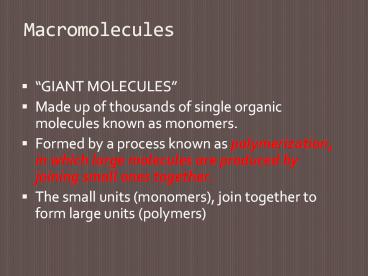Macromolecules - PowerPoint PPT Presentation
Title:
Macromolecules
Description:
Macromolecules GIANT MOLECULES Made up of thousands of single organic molecules known as monomers. Formed by a process known as polymerization, in which large ... – PowerPoint PPT presentation
Number of Views:123
Avg rating:3.0/5.0
Title: Macromolecules
1
Macromolecules
- GIANT MOLECULES
- Made up of thousands of single organic molecules
known as monomers. - Formed by a process known as polymerization, in
which large molecules are produced by joining
small ones together. - The small units (monomers), join together to form
large units (polymers)
2
- Usually consist of many repeating units
- Large in size
- Some examples
Subunit(s)
Example
Category
Glycerol fatty acids
Fat (trigylceride)
Lipids
Monosaccharide
Polysaccharide
Carbohydrates
Amino acid
Polypeptide
Proteins
DNA, RNA
Nucleic Acids
Nucleotide
3
Carbohydrates, Lipids Proteins
- Simple molecules built by covalent bonding and
addition of functional groups. - Biological polymers built of simple molecules
- Assembled and disassembled in very similar
reactions condensation and hydrolysis
4
Carbohydrates
- As the name implies, consist of carbon, hydrogen,
and oxygen - The basic formula for carbohydrates is CH2O,
meaning that there is one carbon atom, two
hydrogen atoms, and one oxygen atom as the ratio
in the structure of carbohydrates - What would be the formula for a carbohydrate that
has 3 carbons? - C3H6O3
5
Condensation and Hydrolysis
- Condensation - Removal of water molecule
- Used to connect monomers together to make
polymers - Polymerization of glucose monomers to make starch
- Hydrolysis - Addition of water molecule
- Used to disassemble polymers into monomer parts
- Digestion of starch into glucose monomers
- Specific enzymes required for each reaction
- Accelerate reaction
- Are not used in the reaction (catalysts)
- What are the main difference between an inorganic
catalyst and biological catalyst? This we will
discover!
6
Synthesis and Degradationof Polymers
7
- Monosaccharides
- Single sugar molecules, commonly known as simple
sugars - Appear as white crystals that are soluble and
sweet to taste - Examples
- Glucose (blood), Fructose (fruit, honey)
Galactose (does not occur naturally) - Hexoses - Six carbon atoms. Isomers of C6H12O6
- Ribose and deoxyribose (in nucleotides)
- Pentoses Five carbon atoms. C5H10O5 and C5H10O4
8
DisaccharidesMonosaccharide molecules react to
form disaccharides condensation/ dehydration/
elimination reaction (all refer to same reaction
type)
Also soluble (due to presence of polar OH groups)
and sweet to taste Examples Sucrose Table
sugar, maple sugar One glucose and one fructose
molecule joined by dehydration Maltose Malt
sugar Two glucoses joined by dehydration
9
Common Monosaccharides, Disaccharides
Polysaccharides
10
Synthesis condensation synthesis (can also be
called dehydration)
- Removal of OH H forms water, H2O
- Ether link (or glycosidic link)-O- formed in
disaccharide.
11
Glycosidic Linkages in Carbohydrates
Water eliminated
12
Disassembly hydrolysis
- Bond between monosaccharide units is broken when
reacted with water. - The OH- H ions fill the ether bonding sites.
13
Polysaccharides
- Build up of more than two monosaccharide units by
condensation - Again can be disassembled by hydrolysis.
14
Polysaccharides
- Polymers of monosaccharides
- Low solubility (non polar) not sweet to taste
- Examples
- Glycogen
- Stored fuel in liver, muscle cells
- Polymer of glucose, unbranched
- Used for short-term energy storage (digestible by
hydrolysis) - Starch
- Polymer of glucose
- Plant equivalent of glycogen
- Used for short-term energy storage (digestible by
hydrolysis) - Often branched chain
- Amylose, corn starch
15
- More polysaccharide examples
- Cellulose
- Long, coiled polymer of glucose
- Very large linear polymer that form
- bundles
- Glucoses connected differently than
- in starch
- Note the different orientations of the CH2OH
groups on adjacent glucose monomers above on
starch (top) and cellulose (bottom) monomers.
Alternating sides in cellulose polymer. - Structural element for plants
- Main component of wood and many natural fibers
- Indigestible by most animals
- Chitin
- Polymer of glucose
- Each glucose with an amino group
- Very resistant to wear and digestion
(indigestible) - Arthropod exoskeletons, cell walls of fungi
16
Starch Structure and Function
17
Glycogen Structure and Function
18
Cellulose Structure and Function
19
Lipids
- Insoluble in water
- Long chains of repeating CH2 units
- Renders molecule Non Polar
- Types of Lipids
Human Uses
Organism Uses
Type
Butter, lard
Long-term energy storage thermal insulation in
animals
Fats
Cooking oils
Long-term energy storage in plants and their seeds
Oils
Component of plasma membrane
No-stick pan spray
Phospholipids
Medicines
Component of plasma membrane hormones
Steroids
20
Lipids
- Larger group, mainly constructed of C and H, some
O - Fats (Triglycerides)
- mostly saturated fatty acids (single carbon
bonds), - unreactive solid at room temperature
- 1 glycerol, 3 fatty acids
- Oils
- unsaturated fatty acids,
- liquid at room temperature
- 1 glycerol, 3 fatty acids
21
Lipids
- Steroids
- unlike other lipids, 4-ring structure
- Phospholipids
- 1 glycerol molecule 2 fatty acids (not three
like fats oils) 1 phosphate-containing acid
22
Types of LipidsTriglycerides (Fats)
- Long-term energy storage
- Assembled of glycerol 3 fatty acids by
condensation synthesis. - Backbone of one Glycerol molecule 3-carbon
chain with 3 hydroxyl groups (OH-) - Fatty acid long carbon backbone with Carboxylic
acid at one end - Carboxylic acid connects to OH on glycerol in
condensation reaction - Three fatty acids attached to each glycerol
molecule
23
Synthesis condensation
- Remove H from glycerol and OH from fatty acids
- Creates ester linkage































